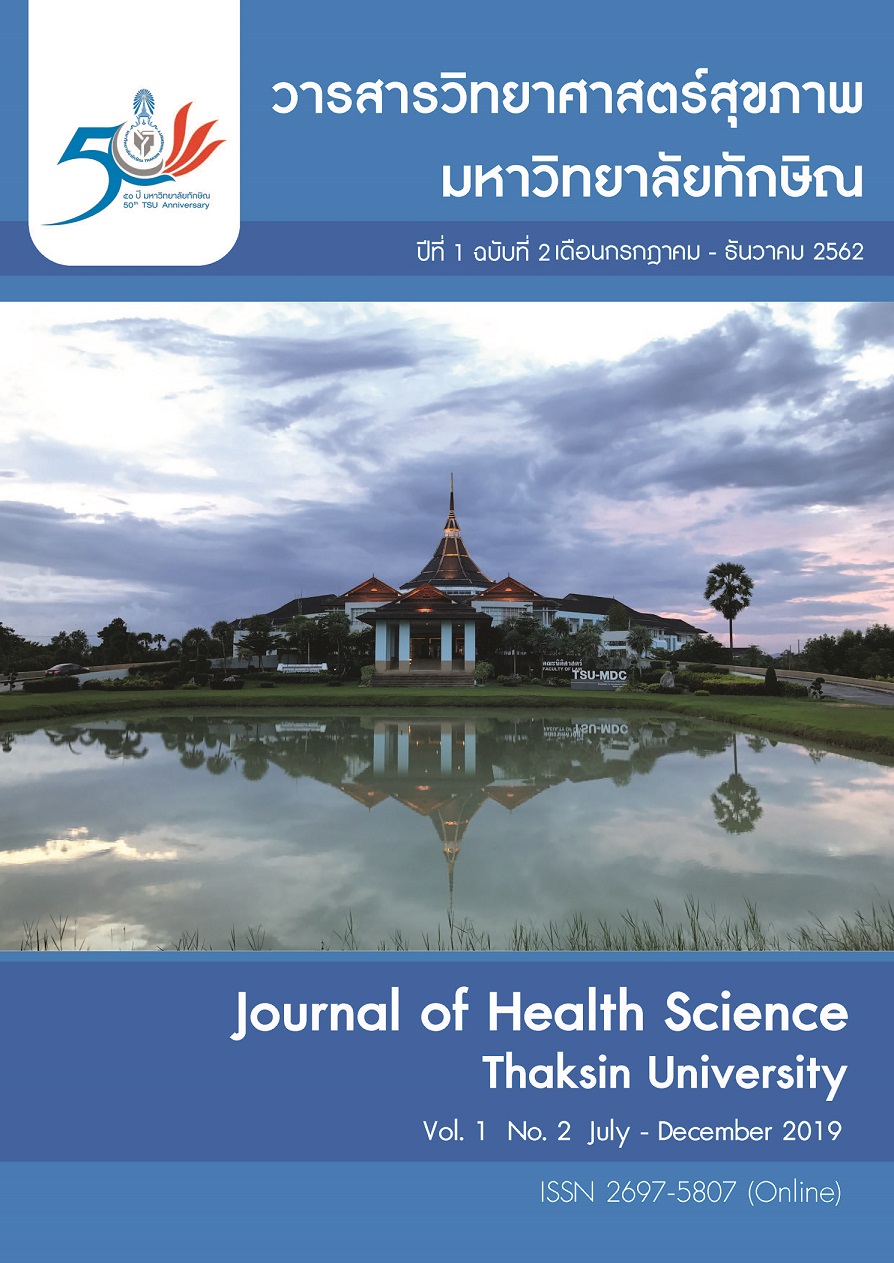Prevalence of Carbapenem-Resistant Enterobacteriaceae Infection Among Patients Attending in Tertiary Care Hospital, Bordering Province of Southern Thailand
Main Article Content
Abstract
The objective of this retrospective descriptive study was to investigate the
prevalence of Carbapennem-Resistant Enterobacteriaceae infection among
patients attending in tertiary care hospital. The investigation of infection was
evaluated by using laboratory testing of culture, bacterial identification and
sensitivity of antimicrobial. The data was gathered from 2014 to 2018. The
prevalence of infection was analyzed and presented by descriptive statistics.
Results shows that the prevalence of infection was 1.6, 1.5, 2.4, 4.3 and 5.4%,
respectively. There were Klebsiella pneumonia (2.1, 2.7, 5.5, 10.0, 12.3%),
Escherchia coli (1.3, 0.7, 1.0, 1.5, 2.6%), and others (1.3, 1.2, 0.4 ,0.9, 1.0%). The
most prevalence of infection was found in urine (17.5%), pus (16.6%), sputum
(13.97%) and blood (7.20%), respectively. The most prevalence of infection was found in department of intensive
care unit (1.9, 2.7, 6.1, 7.5 ,7.5%), medicine (2.0 ,1.5 ,2.8, 5.6, 5.9%), surgery (2.5, 2.1, 2.9, 4.5, 4.9%), and pediatrics
(1.1, 0.6 ,1.3, 2.5, 2.8%), respectively. The enzyme gene testing showed that there was enzyme NDM-1 (50.65%),
enzyme NDM-1 with OXA (19.48%), enzyme OXA (23.37%), enzyme IMP (2.59%) and others (3.89%). Therefor,
medical and related professionals should provide the stringent measures of drug-resistant control particularly, in
intensive care unit department in order to prevent and control the dissemination of drug-resistant microbacterials.
Article Details
References
2. Phumart P, Phodhat T, Thamlikitkul V, Riewpaiboont A, Prakongsai P, Limwattananon S. Health and Economic Impacts of Antimicrobial Resistant Infections in Thailand: A Preliminary Study. Journal of Health Systems Research. 2012; 6(3): 352-360. (In Thai).
3. World Health Organization. The evolving threat of antimicrobial resistance: Options for action 2012. Geneva: WHO.
4. Infectious Diseases Society of America. Combating Antimicrobial Resistance: Policy Recommendations to Save Lives. Clinical Infectious Diseases. 2011; 52(5): S397–S428.
5. Report G. Antimicrobial Resistance. [Internet] 1998 [Cited September 10, 2019]. Available from: http://
www.nap.edu/catalog/6121.
6. Apisarnthanarak A, Danchaivijitr S, Khawcharoenporn T, et al. Effectiveness of education and antibioticcontrol
program in a tertiary care hospital in Thailand. Clin Infect Dis. 2006; 42(6): 768-775. (In Thai).
7. Allcock S, Young E, Holmes M, et al. (2017). Antimicrobial resistance in human populations: Challenges and
opportunities. Global Health, Epidemiology and Genomics 2017; 2: 1-7.
8. Chitpirom P. Jamnak T. Detection of Klebsiella pneumoniae carbapenemase producing Enterobacteracae.
Advanced Science 2016; 16(2): 105-118. (In Thai).
9. Sadsee P. The Prevalence of Carbapenem Resistant Enterobacteriaceae at Somdejphra-choataksinmaharaj
Hospital, Tak. Journal of Bamrasnaradura Infectious Diseases Institute. 2019; 13(2): 78-86. (In Thai).
10. National Antimicrobial Resistance Surveiliance Center, Thailand. Situation of microbactrial resistance to antimicrobials in the reginal health of fiscal year 2018 (12 months) [Internet] 2019 [Cited September
10, 2019]. Available from http://narst.dmsc.moph.go.th.
11. Piwpong C. Incidence of Carbapenemresistant Enterobacteriaceae in Suratthani Hospital. Region 11 Medical Journal. 2016; 30(2): 1-12 (In Thai).
12. Arsheewa W. Carbapenem-Resistant Enterobacteriaceae Prevalence of Carbapenemase Enzyme in Clinical Isolates of Carbapenem-Resistant Enterobacteriaceae from Prapokklao Hospital in 2012 - 2013. The Journal of Prapok-klao Hospital Clinical Medical Education Center. 2559; 33(4): 315–325. (In Thai).
13. Manankul S, Kertsin A. Comparison of Standard Carba NP and Modified CarbaNP for detection of carpapenemase-producing Enterobacteriaceae. Region 11 Medical Journal. 2016; 30(3): 145-157 (In Thai)


